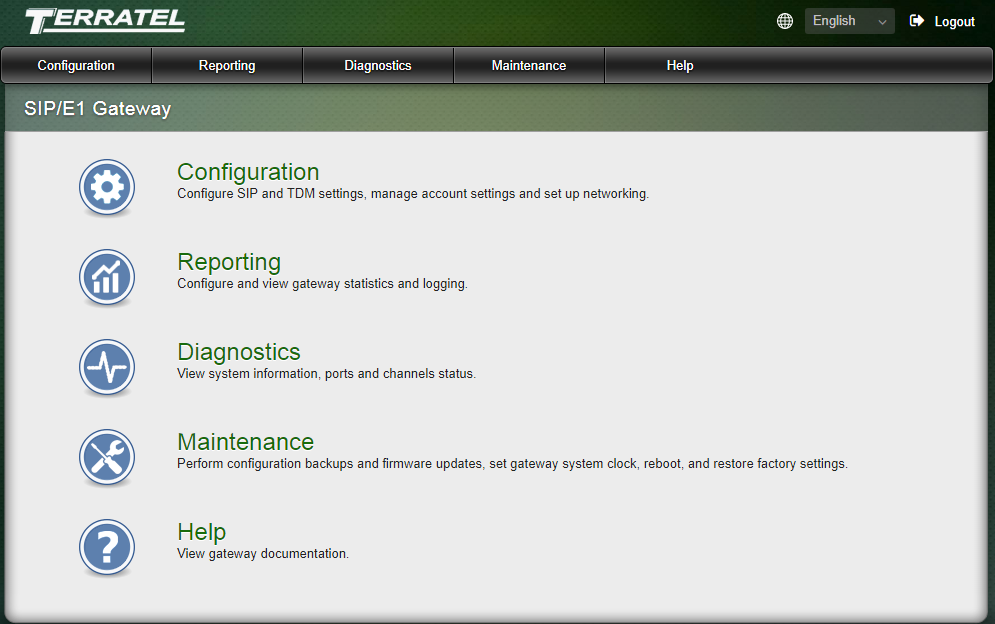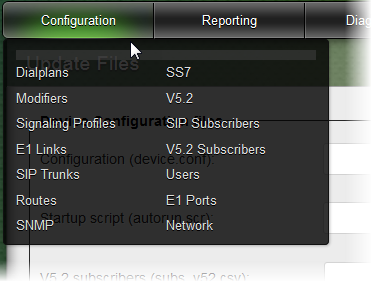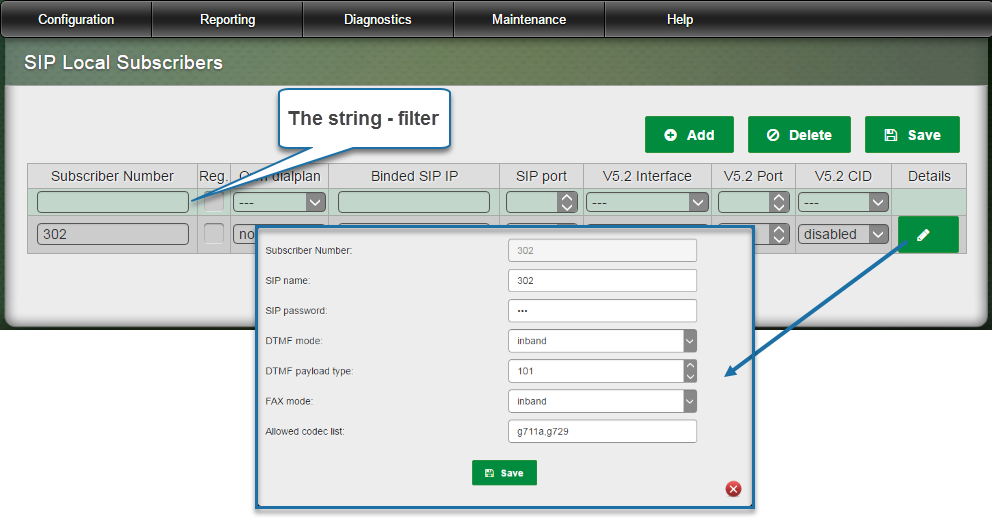Digital VoIP Gateway for integration PSTN/TDM to IP networks
Features
- up to 16 E1 interfaces
- up to 480 VoIP channels
- SS7, ISDN PRI (DSS1, QSIG, Q.931), V5.2, R2 CAS, R2 MFC, R1.5
- SIP, SIP-I, RTP, RTCP, TCP, UDP
- Voice codecs – G.711, G.723.1, G.726, G.729a/b, GSM
- Voice quality – Adaptative jitter buffer, VAD, SID, CNG
- Registration and authentication – up to 10000 SIP-subscribers
- Fax over G.711, T.38 fax relay
- Hardware Echo Cancellation
- Call Routing TDM-SIP, SIP-TDM, TDM-TDM and SIP-SIP
- SNMPv2 monitoring
- RADIUS login
- Security (іntegrated firewall, password protected access, SSH)
- AC/DC dual redundant power supply
- Network Element Remote Monitoring System
Overview
SIP/E1 Media Gateway – Digital VoIP gateway is used in different options of conjugation of VoIP and TDM/PSTN networks for minimization of expenses and reduction of operational costs. Support for all types of signaling used in the PSTN network allows the use of Terratel VoIP gateway for the reconstruction and modernization of various telecommunications equipment.

Pic 1. SIP/E1 Gateway Connection Block Diagram.
SIP/E1 Media Gateway supports call routing in any order TDM-to-SIP, SIP-to-TDM, TDM-to-TDM, and SIP-to-SIP.
Functionality
SIP/E1 Media Gateway supports the following signaling protocols used by the PSTN:
- SIP
- SS7 (Common Channel Signaling System No. 7, SS No. 7, Signaling System No. 7, CCS7 Common Channel Signaing System 7, C7, CCITT7, N7 or Signalisierungssystem Nummer 7)
- ISDN PRI (or Euro-ISDN, E-DSS1, EDSS1, DSS1, QSIG, Q.931)
- V5.2 LE and V5.2 AN
- CAS R2
- R2 MFC
- R1.5
The product features a number of functionalities that provide:
- translating calls to IP network over SIP with G.711, G.723.1, G.726, G.729a/b, GSM, T.38 support
- Echo Cancellation as recommended ITU-T G.168 up to 128 ms
- call routing in any order TDM-SIP, SIP-TDM, TDM-TDM, and SIP-SIP
- fully accessible non-blocking switching of up to 16 E1 ports (G.703)
- transparent conversion of signaling protocols of E1 ports between exchanges
- allocating E1 port channels between several E1 port
- assigning signaling protocols for each E1 port (or part of E1 port)
- redirecting telephone connection depending on the subscriber number
- converting the subscriber number when the connection is being established over the assigned masks (deleting digits, inserting prefixes)
- combining several telephone exchanges into a corporate network with internal dialling plan
Application
Since the product can establish IP-TDM, TDM-IP, SIP-SIP and TDM-TDM connections and supports a wide range of telephony signaling protocols and interfaces its functionalities include:
- E1 PCM Multiplexer
- Signaling Converter
- Digital TDM Switch
- SIP to E1 Gateway
- Corporate VoIP communications
- SS7 VoIP Gateway
- V5.2 VoIP Gateway
- ISDN PRI VoIP Gateway
- R2 CAS VoIP Gateway
IP-PBX with VAS (value-added services) Support
This functionality allows to use the gateway as IP-PBX that can register up to 5000 SIP subscribers with VAS (value added services) support.
IP-PBX allows to combine divisions and branches of a company that are located in different places into a single telephone network.
The gateway software allows to map TDM network subscribers (for example, subscribers of remote exchange capacities connected to the gateway over V5.2) to SIP accounts of VoIP network with assigned authentication parameters.
Redundant Power Supply Support
To provide stable operation when there is a risk of power failures the product provides for installing the redundant power supply.
Depending on the product variant various power supply schemes are supported: power supply from two (2) 48V/60V DC voltage supplies and/or two (2) 110V-220V AC voltage supplies.

Pic 2. AC/DC Redundant Power Supply Support.
Power supply units feature the following specifications:
- for AC voltage 100-240V, 1.5A max, 50-60 Hz
- for DC voltage 36-72V (48V rated voltage), 4A max
Power consumption in full configuration (16Е1) – up to 30W.
Low consumption and supply from several power supplies at a time provide for smooth operation of the product, which is critical for the service provider.
100/1000 Base-T Ethernet Backup Port and Visual Indication
In its standard configuration the product is equipped with two 100/1000 Base-T Ethernet ports with RJ-45 connectors.
This technical solution is designed to share traffic as well as the network management and monitoring to allow the service provider to increase the network survivability.

Pic 3. 100/1000 Base-T Ethernet Backup Port and Visual Indication.
Visual LED indication of LAN status is output on Gigabyt Ethernet port connectors.
The front panel also features the product status and alarm LED indicators, E1 port status LED indicators, and the reset button.
Synchronous Ethernet (SyncE)
Synchronous Ethernet (SyncE) is the ITU-T standard designed to make the transfer of synchronization signals over the Ethernet physical layer easier. High quality of frequency and time synchronization is required for many critical applications of the carrier class packet network including the operation of mobile communications systems and transfer of channel signal streams of plesiochronous (PDH) and synchronous (SDH) hierarchy over the packet switched network.
Synchronous Ethernet should be integrated into the Ethernet common architecture and the synchronization network architecture.
Terratel VoIP Gateway supports SyncE at the hardware level (according to ITU-T G.8261/Y.1361 and G.8262/Y.1362 recommendations and standards).
Both Gigabyt Ethernet ports support SyncE.
The synchronization signal can be restored from the received signal of the synchronous Ethernet and any E1 port can be used to forward the synchronization signal from TDM to Ethernet as the synchronization source for SyncE.
This feature is an option and it is not included in the standard configuration.
Management and Settings
The product is managed and configured with the user-friendly graphical interface using the integrated Web server.
The Web interface is intuitive and visually appealing.
To control the product two types of user accounts are used: “Administrator” and “User”.
When the user meets the authorization conditions he/she will access the main web page of the VoIP gateway management interface.

Pic 4. SIP/E1 Gateway Web Interface – Main Device Management menu
The product can be configured for operation in TDM and IP networks in Configuration section.
This section allows to create the lists of number templates, edit subscriber numbers, create and modify SIP user accounts, set up SS7 signaling point parameters and V5.2 interface parameters for servicing remote exchange capacities, configure ISDN PRI and R2 CAS signaling parameters, specify physical parameters of the 2 Mb E1 port and many more.
Reporting, Diagnostics, and Maintenance sections are designed to monitor and maintain the gateway.
VoIP gateway operation monitoring can be performed over SNMP network control protocol by generating alarm messages.
SIP/E1 Media Gateway provides the integrated SNMP agent.
SNMP agent sends alarm messages to the controlling SNMP manager in real time.
SNMP agent also supports monitoring of the product status upon request from SNMP manager.
The alarm message monitoring function is activated in Configuration section – SNMP.
TDM Interface Support
Depending on the connection diagram of the product the service provider can immediately configure, activate and deactivate E1 TDM ports.
This is important when it is required to set up quickly new connections both within the network and with different service providers who use E1 connections.
The maximum number of E1 ports within a single unit is 16 and the minimum number is 2.
Since up to 16 E1 ports can be supported there is no need to install additional equipment when expanding the number of the communication links.
VoIP gateway is connected to E1 terminal equipment using a twisted pair with wave resistance of 120 Ohm via RJ-45 connectors.
Each E1 port supports 2.048 Mbps data stream in accordance with ITU G.703 standard.
Terratel VoIP media gateway makes E1 interface configuration and support flexible.
E1 ports are configured in Configuration section.
PSTN Signaling Protocols Selection and Configuration
The key requirement for the service provider when deploying this type of the equipment is to support several signaling protocols at a time.
At the same time several signaling protocols should be supported both within the telecommunications network of the service provider and between his partners.
Each Terratel VoIP Gateway supports simultaneous use of the following signaling protocols within a single device: SS7, ISDN PRI DSS1, V5.2, R2 CAS, SIP.
The required signaling protocol can be selected and configured using the Web interface in Configuration section.

Pic 5. Web Interface – Configuring and setting signaling protocols
To provide flexibility and save costs priority should be given to enabling and converting several TDM and SIP-over-IP signaling protocols at a time.
Configuring SIP Trunking and SIP Subscribers
SIP trunk is a virtual version of an analog telephone line.
“SIP Trunks” section is designed to control groups of IP lines combined within the same SIP authorization. Each SIP trunk has its own set of primary and additional parameters (The name of the created SIP trunk, Signaling profile, Unconditional route, Primary SIP server, Reserve SIP server, Availability check timeout and ect.).

Pic 6. SIP/E1 Media Gateway Web Interface – Configuring SIP Tranks.
Device uses SIP (Session Initiation Protocol) for operating in IP networks.
SIP is the protocol for establishing the user Internet session designed to establish multimedia conferences and phone connections and distribute multimedia information.
Device allows to configure the registration of SIP subscribers and make voice calls subsequently within both SIP and PSTN networks using E1 port channels. In other words it features the functionalities of an IP-PBX.

Pic 7. SIP/E1 Media Gateway Web Interface – Configuring SIP Subscribers
VoIP and FoIP Codecs
VoIP or audio codec is a mathematical algorithm for converting and compressing the audio signal into digital packets and back.
Depending on the requirements to the network load and computational resources the service provider can use several codecs and implement several compression methods in his VoIP network.
Selecting the optimum codec based on the network conditions will save the capacity and provide excellent quality of sound transmission.
Support of several parallel codecs and their distribution in real time based on the traffic is the basis for providing the true network convergence.
Terratel VoIP media gateways are supplied with G.711 (a-law, µ-law), G723.1, G.726, and G.729ab support without requiring any additional fees for the license while providing smooth recoding in real time.
G.711 (PCM) broadband codec provides the highest sound quality, however it features the highest traffic level.
For example G.711 (a-law, µ-law) codec requires connection speed that is almost 3 times higher than that required by G.729 codec.
The narrowband codecs have low bit rate and high compression rate and that is why they are preferred when the network capacity is limited.
G.723.1, G.726 and G.729a narrowband codecs have different sound quality, in descending order.
When configuring the product it is required to specify the priority for using the codecs in VoIP system.
The codec that was selected properly will significantly increase the sound quality.
Facsimile communication over IP network uses T.38 Real-Time Fax protocol and G.711 (a-law, µ-law) pass-through.
Terratel VoIP Gateways provide support of the Internet fax known as Fax-over-IP using T.38 protocol.
Echo Cancellation and Voice processing
Echo cancellation is necessary for packet-switched networks to carry voice traffic high-quality. SIP/E1 Media Gateway conform to ITU G.168 echo cancellation with a tail length up to 128 ms.
Voice processing – these are standard methods for improving speech quality that are used to eliminate echo, noise, determine silence in voice and audio applications.
Device functionally supports:
- Adaptative programmable jitter buffer
- Voice activity detection (VAD)
- Silence insertion descriptor (SID)
- Comfort noise generation (CNG)
Reporting for Payment Systems
Terratel VoIP Gateways can integrate into several payment platforms and systems.
Reports for the external side are provided as CDR files.
The detailed call data records (CDR) contain important statistics about the calls made using the product.
CDRs are generated at the end of each call.
After they are generated they are sent to Syslog server.
Generation of call records is initialized in Configuration section of the VoIP gateway Web interface.
System Density
Terratel VoIP Gateways are made in 1U form factor and they have high system density.
These factors allow to save costs by reducing the quantity of the equipment to be bought for the service provider and save operating costs by reducing the amount to be paid for the placement of the equipment in the data center and reducing power and cooling costs.
Energy Efficiency
Minimum power consumption is an important criterion for a service provider selecting the equipment.
Terratel VoIP Gateways feature the adaptive power consumption system that provides for reducing power consumption by 30% in comparison with the similar equipment.
Terratel VoIP Gateways can play an important role in reducing power costs.
Technical Specifications
| Network Interfaces | |
|---|---|
| TDM | up to 16 E1 interfaces |
| SIP and RTP | up to 480 VoIP channels, 10/100/1000 BASE-T Ethernet |
| Management | Fast Ethernet, RS-232 |
| Signaling Protocols | |
|---|---|
| IP | SIP, SIP-I, RTP, RTCP, TCP, UDP |
| PSTN | SS7, ISDN PRI (DSS1, QSIG, Q.931), V5.2, R2 MFC, R2 CAS, R1.5 |
| Feature Support | |
|---|---|
| Voice codecs | G.711 (a-law, µ-law), G.723.1, G.726, G.729a/b, GSM |
| Voice processing | Adaptative programmable jitter buffer, VAD, SID, CNG |
| DTMF | RFC2833, SIP INFO, RFC 2976 |
| FAX | fax over G.711, T.38 fax relay |
| Echo Cancellation | G.168 up to 128 ms |
| Registration and Authentication | up to 10000 SIP-subscribers |
| Registration | SIP-trunks |
| Call Routing | TDM-SIP, SIP-TDM, TDM-TDM and SIP-SIP |
| Power | |
|---|---|
| Single/Dual-redundant 220 VAC or/and 48/60 VDC Input | |
| Up to 28W Power consumption (for 16 E1) |
| Operations Management | |
|---|---|
| GUI via Embedded Web Server | |
| SNMPv2 monitoring | |
| Syslog Telnet (for CLI) |
| Security | |
|---|---|
| Integrated firewall, Password protected access, SSH, RADIUS login |
| Operating Environment | |
|---|---|
| Operating temperature | from 0°С to +60°СHumidity |
| Humidity | up to 80% at +25°С |
| Hardware | |
|---|---|
| System Type | Board |
| Dimensions | 1U high, 19″ wide rack mountable |
Delivery Set
SIP/E1 Gateway Lite:
- SIP/E1 Gateway Lite (1Е1, 30 SIP channels, G.711, T38 codecs, echo cancellation G.168)
SIP/E1 Media Gateway:
- SIP/E1 Gateway (2Е1, 240 SIP channels, G.711, G.726, G.729, T38 codecs, echo cancellation G.168)
- SIP/E1 Gateway (4Е1, 240 SIP channels, G.711, G.726, G.729, T38 codecs, echo cancellation G.168)
- SIP/E1 Gateway (8Е1, 240 SIP channels, G.711, G.726, G.729, T38 codecs, echo cancellation G.168)
- SIP/E1 Gateway (12Е1, 240 SIP channels, G.711, G.726, G.729, T38 codecs, echo cancellation G.168)
- SIP/E1 Gateway (16Е1, 480 SIP channels, G.711, G.726, G.729, T38 codecs, echo cancellation G.168)
